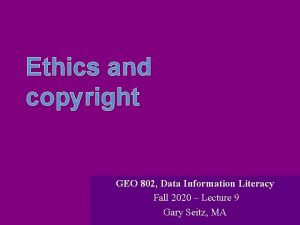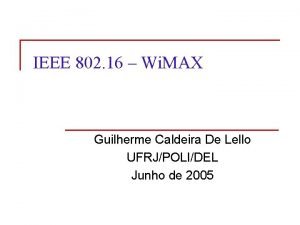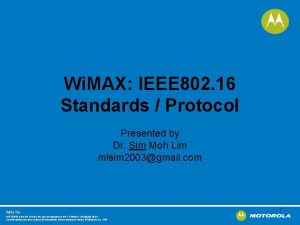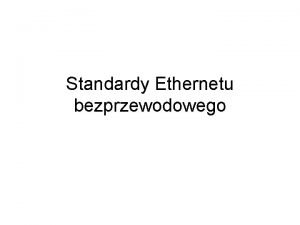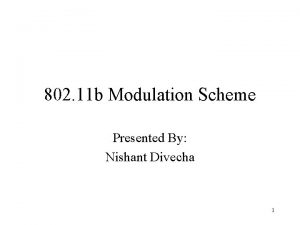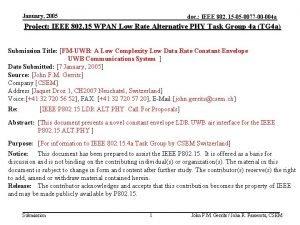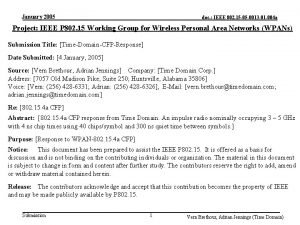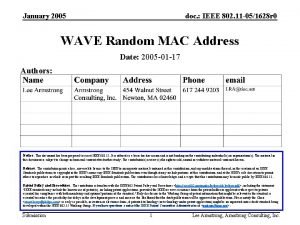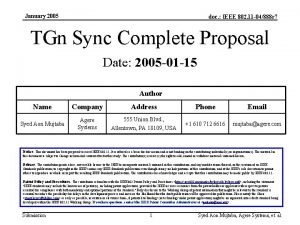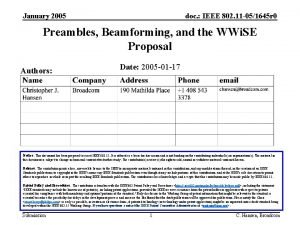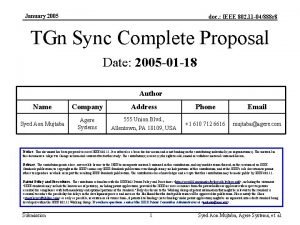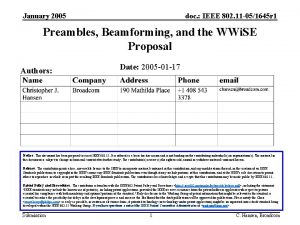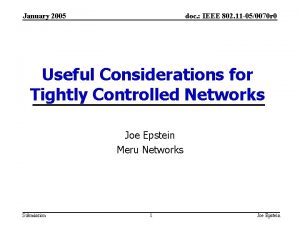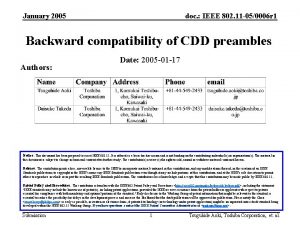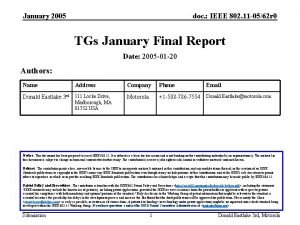January 2005 doc IEEE 802 11 051615 r















- Slides: 15

January 2005 doc. : IEEE 802. 11 -05/1615 r 1 Transmit Link Qo. S Metrics Date: 2005 -01 -12 Authors: Notice: This document has been prepared to assist IEEE 802. 11. It is offered as a basis for discussion and is not binding on the contributing individual(s) or organization(s). The material in this document is subject to change in form and content after further study. The contributor(s) reserve(s) the right to add, amend or withdraw material contained herein. Release: The contributor grants a free, irrevocable license to the IEEE to incorporate material contained in this contribution, and any modifications thereof, in the creation of an IEEE Standards publication; to copyright in the IEEE’s name any IEEE Standards publication even though it may include portions of this contribution; and at the IEEE’s sole discretion to permit others to reproduce in whole or in part the resulting IEEE Standards publication. The contributor also acknowledges and accepts that this contribution may be made public by IEEE 802. 11. Patent Policy and Procedures: The contributor is familiar with the IEEE 802 Patent Policy and Procedures <http: // ieee 802. org/guides/bylaws/sb-bylaws. pdf>, including the statement "IEEE standards may include the known use of patent(s), including patent applications, provided the IEEE receives assurance from the patent holder or applicant with respect to patents essential for compliance with both mandatory and optional portions of the standard. " Early disclosure to the Working Group of patent information that might be relevant to the standard is essential to reduce the possibility for delays in the development process and increase the likelihood that the draft publication will be approved for publication. Please notify the Chair <stuart. kerry@philips. com> as early as possible, in written or electronic form, if patented technology (or technology under patent application) might be incorporated into a draft standard being developed within the IEEE 802. 11 Working Group. If you have questions, contact the IEEE Patent Committee Administrator at <patcom@ieee. org>. Submission 1 Emily Qi, Intel Corporation

January 2005 doc. : IEEE 802. 11 -05/1615 r 1 Abstract This submission contains a proposal to add Quality of Service (Qo. S) and Quality of Signal Metrics to the latest TGk draft. The proposed Qo. S metrics include Transmit frame count, Frame loss count, Retransmission Count, Average Transmit delay, Minimum transmit delay, and Maximum transmit delay. This contribution provides resolution for LB 71 comment#928, #933, etc. . Submission 2 Emily Qi, Intel Corporation

January 2005 doc. : IEEE 802. 11 -05/1615 r 1 Motivation • Vo. IP and Video/Audio stream become prominent applications in Wi. Fi • IEEE 802. 11 e provides Qo. S for real-time traffics to meet the requirements: – max latency – min data rate – max packet drop probability • IEEE 802. 11 k draft lacks the measurements to capture Quality of Service and Quality of Signal performance. • Provide resolution for LB 71 comment#928, #933, etc. Submission 3 Emily Qi, Intel Corporation

January 2005 doc. : IEEE 802. 11 -05/1615 r 1 Proposal Overview • Define Transmit Link Qo. S Metrics as a new measurement type • Transmit Link Qo. S metrics include: – Transmit frame count (MSDU) Frame Loss Rate – Frame loss count (MSDU) Frame Error Rate – Retransmission count (MSDU) – Latency: Average transmit delay – Jitter: Min transmit delay and Max transmit delay • Transmit Link Qo. S metrics are per traffic category/stream (TID) for QSTA or for all traffics for non-QSTA • Transmit Link Qo. S metrics is per link - per destination • The measuring traffic is the stream that sent from the measuring STA to the STA with specified destination address • The requesting STA and reporting STA could be a QSTA or non-QSTA Submission 4 Emily Qi, Intel Corporation

January 2005 doc. : IEEE 802. 11 -05/1615 r 1 Add New Measurement Type Measurement Name Submission Unused 0 -2 Channel Load Request 3 Noise Histogram Request 4 Beacon Request 5 Frame Request 6 Hidden Node Request 7 Medium Sensing Time Histogram Request 8 STA Statistics Request 9 Transmit Link Qo. S Metrics Request 10 Reserved 11 -255 5 Emily Qi, Intel Corporation

January 2005 doc. : IEEE 802. 11 -05/1615 r 1 Transmit Link Qo. S Metrics Request Octets: • • • Randomization Interval Measurement Duration Destination Address Traffic Identifier (TID) 2 2 6 1 Destination Address contains the 6 -byte MAC address of the intermediate destination of the measuring traffics. The measuring traffic is the stream that sent from the measuring STA to the STA with specified destination address TID field – Value 0 -7 indicate the UP of prioritized Qo. S (TC) and TS with access policy set to EDCA – Value 8 -15 indicate TSID for TS with access policy set to a value other than EDCA – Value 255 indicates the Qo. S metrics will be measured all of traffics, - allow both QSTA and non-QSTA to have Qo. S metrics request – Value 16 -254 are reserved values Submission 6 Emily Qi, Intel Corporation

January 2005 doc. : IEEE 802. 11 -05/1615 r 1 Transmit Link Qo. S Metrics Report Fields Submission Octets Actual Measurement Start time 8 Measurement Duration 2 Destination Address 6 TID 1 Transmit Frame Count 4 Frame Loss Count 4 Retransmission Count 4 Average Transmit Delay 4 Minimum Transmit Delay 4 Maximum Transmit Delay 4 7 Emily Qi, Intel Corporation

January 2005 doc. : IEEE 802. 11 -05/1615 r 1 Transmit Frame (MSDU) Count • Definition: The total number of MSDU which are successfully transmitted after 0 or n reties during the measurement duration for the specified destination and the specified TID • Usages: An indication of traffic capacity and be used for calculating frame loss rate • 4 octets long Submission 8 Emily Qi, Intel Corporation

January 2005 doc. : IEEE 802. 11 -05/1615 r 1 Frame Loss Count • Definition: The total number of MSDU which are discarded after given numbers of retries, or when MSDU timer is expired, during the measurement duration for the specified destination and the specified TID • Usages: An indication of link quality and voice/video stream quality • 4 octets long Submission 9 Emily Qi, Intel Corporation

January 2005 doc. : IEEE 802. 11 -05/1615 r 1 Retransmission Count (MSDU) • Definition: The total number of retries for successfully transmitted frames (MSDU) and discarded frames (MDSU) during the measurement duration for the specified destination and the specified TID • Usages: An indication of link quality and can be used for calculation of frame error rate • 4 octets long Submission 10 Emily Qi, Intel Corporation

January 2005 doc. : IEEE 802. 11 -05/1615 r 1 Transmit Frame Delay • Definition: – – • • Delay is measured from the time MPDU is contending for medium to the start of successful transmission attempt. Measure Average, Min, and Max delay of MPDUs that are successfully transmitted during the measurement duration for the specified destination and the specified TID. Usages: indications of voice/video stream quality (latency and Jitter), and help AP on admission control and Scheduling. 4 octets long, in units of milliseconds Submission 11 Emily Qi, Intel Corporation

January 2005 doc. : IEEE 802. 11 -05/1615 r 1 Why Per TID? • • • For QSTAs, different Traffic Streaming and Traffic Category have different priority which may experience a different delay For QSTAs, Different TC and TS have the different requirements with frame loss rate and retransmission rate. For non-QSTAs, Qo. S metrics will be measured over all of traffics with specified destination address Submission 12 Emily Qi, Intel Corporation

January 2005 doc. : IEEE 802. 11 -05/1615 r 1 Normative Text • 11 -05 -1637 -00 -000 k-proposed-normative-text-qosmetrics. doc Submission 13 Emily Qi, Intel Corporation

January 2005 doc. : IEEE 802. 11 -05/1615 r 1 References • 11 -04 -1204 -02 -000 k-Qo. S-Statistics. ppt • 11 -04 -1395 -00 -000 k-qos-statistics-normative-text. doc Submission 14 Emily Qi, Intel Corporation

January 2005 doc. : IEEE 802. 11 -05/1615 r 1 Feedback? Submission 15 Emily Qi, Intel Corporation











